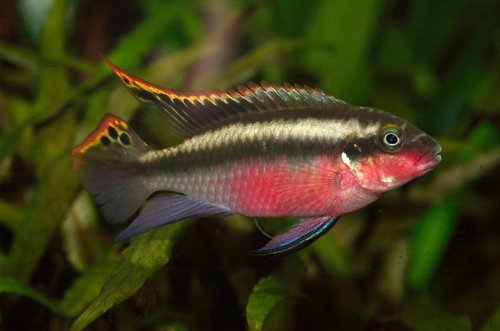
Kribensis
The Atlantic bluefin tuna (Thunnus thynnus) is a highly migratory, large pelagic fish renowned for its size, speed, and commercial value. As one of the ocean's top predators, it plays a crucial role in the marine ecosystem. This species is also culturally and economically significant, particularly prized in sushi markets worldwide.
3 5 years
Lifespan
7 - 10 cm
Length
Least Concern
Conservation Status
N/A km/h
Swimming speed
Omnivorous
Diet
Sedentary
Migration
Appearance Overview
The Atlantic bluefin tuna is a large, streamlined fish with a metallic blue body and a silvery belly.
Coloration
Dark metallic blue on top, silvery-white underside.
Body Shape
Torpedo-shaped, built for speed and endurance.
Fins
Two dorsal fins, the first depressible; small finlets running down the back and belly towards the tail.
Length
Up to 13 feet (4 meters)
Weight
Up to 2,000 lbs (907 kg)
Diet
Carnivorous, feeding on a variety of fish, squid, eels, and crustaceans.
Feeding Behavior
Opportunistic and highly active predators, bluefin tuna use their speed and agility to hunt. They often hunt cooperatively, herding and corralling smaller fish.
Social Behavior
Highly migratory, forming large schools, especially during spawning season. They exhibit complex social behaviors, including coordinated hunting.
Commercial Relevance
Extremely high value, particularly in sushi and sashimi markets, where a single fish can be sold for hundreds of thousands of dollars.
Conservation measures
Subject to international fishing quotas and regulations managed by organizations like the ICCAT. Conservation efforts include tagging programs to monitor populations, and fishing gear restrictions.
Status
Endangered
Threats
Overfishing is the primary threat. Other significant threats include bycatch in fishing gear, habitat degradation, and climate change affecting prey availability.
Habitat Distribution
Depth Range
Typically found from the surface to depths of 500-1,000 meters.
Geographic Range
Atlantic Ocean; western Atlantic, eastern Atlantic and the Mediterranean Sea.
Preferred Environment
Pelagic, preferring temperate and subtropical waters. They are highly migratory, traversing vast oceanic distances.
Reproduction and Life Cycle
Breeding Habits
Spawning occurs in warm waters, primarily in the Mediterranean Sea and the Gulf of Mexico. Spawning typically takes place from May to July in the Gulf of Mexico and from June to August in the Mediterranean.
Development Stages
Eggs hatch into larvae within a few days. The larvae are planktonic and undergo rapid growth. Juveniles develop quickly, eventually adopting the predatory lifestyle of adults.
Fecundity
Highly fecund; a single female can produce up to 30 million eggs per spawning season.
Maturity Age
Reaches sexual maturity relatively late, at around 4-8 years of age.
Faqs about Kribensis
Where can Atlantic bluefin tuna be found?
They are primarily found in the Atlantic Ocean, ranging from Newfoundland to the Mediterranean Sea.
How long do bluefin tuna live?
They can live up to 40 years.
How fast can bluefin tuna swim?
They are among the fastest fish in the ocean, capable of bursts of speed up to 40-60 mph.
Are Atlantic bluefin tuna warm-blooded?
Atlantic bluefin tuna are warm-blooded, which is rare among fish. This allows them to maintain a higher body temperature than the surrounding water, aiding in their speed and endurance.
Are there international efforts to protect bluefin tuna?
Yes, through organizations like the International Commission for the Conservation of Atlantic Tunas (ICCAT), which sets fishing quotas and regulations.
Where do Atlantic Bluefin Tuna spawn?
They spawn in the Mediterranean Sea and the Gulf of Mexico.
When do they reach maturity?
They can reach sexual maturity between 4-8 years of age, depending on their location and environmental conditions.
Copyright @ Nature Style Limited. All Rights Reserved.
 English
English